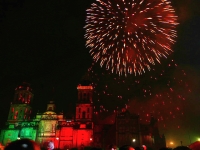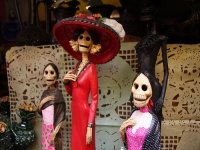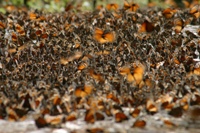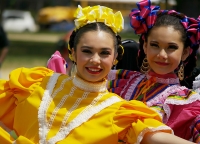What’s on in Mexico City

Candlemas Day
2 February annually
Streets and churches throughout the city
Marking the end of the festive season, Candlemas Day is a nationwide traditional celebration, partly a Catholic tradition and partly a pre-Hispanic ritual. The day is primarily a f…
Candlemas Day
2 February annually
Streets and churches throughout the city
Marking the end of the festive season, Candlemas Day is a nationwide traditional celebration, partly a Catholic tradition and partly a pre-Hispanic ritual. The day is primarily a family celebration and a time of reunions and religious worship; often a chosen member of each family hosts a party, offering tasty tamales and atole (a beverage made from corn). There are numerous street parades with groups carrying representations of Baby Jesus to church where special masses are held. The festival is celebrated all over Mexico but places such as Mexico City, Veracruz and Tlacotalpan host the biggest markets, street parties, and bullfights, turning the religious celebration into a festive, public affair; whereas the smaller towns and villages often restrict their celebrations to the church and home.

Independence Day
16 September annually
Zocalo and city streets
Mexicans celebrate the anniversary of their independence with great gusto, particularly in Mexico City where the main plaza fills with throngs of people from early morning awaiting…
Independence Day
16 September annually
Zocalo and city streets
Mexicans celebrate the anniversary of their independence with great gusto, particularly in Mexico City where the main plaza fills with throngs of people from early morning awaiting the appearance of the president on the balcony of the National Palace. The president duly appears to shout the Cry, a re-enactment of the 1810 call to independence by Father Hidalgo. The original cry was pronounced in the small town of Dolores, near Guanajuato, marking the beginning of the War of Independence. Most towns, villages and cities have similar gatherings, with lots of festive paraphernalia like confetti and whistles in the Mexican colours of green, white and red. The following day a three-hour military parade begins at the Zocalo and ends at the Angel Monument.

Day of the Dead
01 — 02 November annually
The Day of the Dead is a Mexican custom with Aztec roots, celebrating the memory of the dead with prayers, parties and visits to graves. In most regions, 1 November honours lost ch…
Day of the Dead
01 — 02 November annually
The Day of the Dead is a Mexican custom with Aztec roots, celebrating the memory of the dead with prayers, parties and visits to graves. In most regions, 1 November honours lost children and infants, whereas 2 November honours dead adults. The Mexican celebrations coincide with the Catholic holidays of All Saints' Day and All Souls' Day, with markets and stores in Mexico City liberally stocking up on candy skulls, paper skeletons and candles. Processions head towards cemeteries, where vigils or even parties occur and the favourite foods and possessions of dead relatives are often left at graves. Visitors to Mexico City should head for Mixquic, a mountain pueblo south of the city. It hosts an elaborate street fair and solemn processions to the town cemetery.

Migration of the Monarch Butterflies
February and March annually
The Monarch Butterfly Biosphere Reserve
In Autumn each year, the Monarch butterflies gather in southern Canada and begin a journey across North America to Mexico. The insects that begin the journey in Canada will never s…
Migration of the Monarch Butterflies
February and March annually
The Monarch Butterfly Biosphere Reserve
In Autumn each year, the Monarch butterflies gather in southern Canada and begin a journey across North America to Mexico. The insects that begin the journey in Canada will never see Mexico, but their great-great-grandchildren will eventually make it to the small town of Angangueo in Michoacan province some 3,100 miles (5000km) from the start of this epic journey. Like the butterflies, tourists flock to the small town of Angangueo to see the millions of bright orange butterflies flooding the sky and some say you can literally hear their wings beating. The annual migration of the Monarch butterflies is one of nature's great mysteries, continuing to baffle biologists and nature lovers worldwide.

Cinco de Mayo
05 May annually
Puebla, east of Mexico City
On every Fifth of May in the state of Puebla, the famous Battle of Puebla is commemorated with traditional music, dancing and festivities. The battle saw an outnumbered Mexican arm…
Cinco de Mayo
05 May annually
Puebla, east of Mexico City
On every Fifth of May in the state of Puebla, the famous Battle of Puebla is commemorated with traditional music, dancing and festivities. The battle saw an outnumbered Mexican army defeat a larger and better equipped French army on 5 May, 1862. The French invading force, then considered the strongest army in the world, encountered fierce resistance from Mexican defenders at the forts of Loreto and Guadalupe, with 4,500 Mexican troops unexpectedly defeating the 8,000-strong French force. The name 'Cinco de Mayo' is used more by the US, as the Mexicans often call the festival El Dia de la Batalla de Puebla. The battle is still commemorated enthusiastically, mainly with street fiestas and parades, but the epicentre of the festivities is in Puebla.



